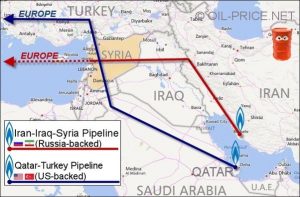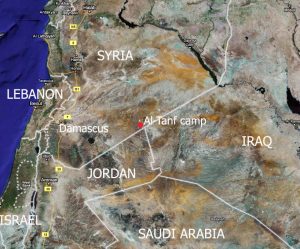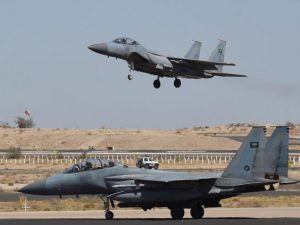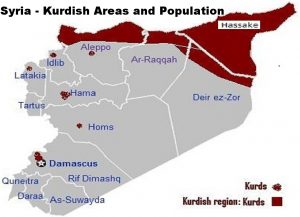Brian M Downing
Candidate Trump promised a tougher stance toward Iran. He deplored the P5+1 deal that required Iran to dismantle critical parts of its nuclear program in exchange for sanctions relief. President Trump has altered many of his positions but remains hostile toward Iran.
The position advanced here recently is that the US will not attack Iran directly. That would irritate European allies already leery of the Trump administration and also elicit a strong response from Moscow. The US will, however, strike Iranian assets in Yemen and Syria.1
 Plans are being made for action against the Iran-backed Houthis in Yemen. The first blow against Iranian assets in Syria came late last week in a remote eastern part of the country, far from most of the fighting. It might signal a range of actions that include blocking the “Shia Corridor” connecting four Shia powers and bringing Iranian hydrocarbons to Mediterranean ports and Europe. The US and Qatar plan an alternate route through Saudi Arabia and Jordan. The fight is on.
Plans are being made for action against the Iran-backed Houthis in Yemen. The first blow against Iranian assets in Syria came late last week in a remote eastern part of the country, far from most of the fighting. It might signal a range of actions that include blocking the “Shia Corridor” connecting four Shia powers and bringing Iranian hydrocarbons to Mediterranean ports and Europe. The US and Qatar plan an alternate route through Saudi Arabia and Jordan. The fight is on.
Eastern Syria (and western Iraq)
 Late last week, American aircraft struck a convoy of pro-Assad militia near Tanf, a small post in eastern Syria where rebel forces have a garrison. American and British special forces have intermittent presences there. The area is remote, far from most of the fighting in the north, far from the embattled ISIL capital of Reqqa. Why are pro-regime forces there? Why are western special forces there?
Late last week, American aircraft struck a convoy of pro-Assad militia near Tanf, a small post in eastern Syria where rebel forces have a garrison. American and British special forces have intermittent presences there. The area is remote, far from most of the fighting in the north, far from the embattled ISIL capital of Reqqa. Why are pro-regime forces there? Why are western special forces there?
Iran and Syria, not without reason, feel besieged by wealthier, more populated Sunni powers. The Shias are determined to maintain a land route linking Iran and Iraq, Syria and Hisbollah parts of Lebanon – the Shia Corridor. Road construction is underway. So is opposition to it.
The Sunni countries, and Israel as well, see the Shia Corridor as a threat. It will unite the four countries commercially and militarily and may one day pose a danger to wealthy but frail Sunni states. Some have sizable Shia minorities, some like Bahrain have large Shia majorities. All of them have repressed Shia populations which the Sunni princes see as fifth columns.
Sunnistan?
 The Sunnis have brought American and British governments into the Shia Corridor question. Riyadh has been trying for years to help Washington and London see the Shia threat. Only last week, on the occasion of President Trump’s visit to Riyadh, Saudi Arabia agreed to purchase $110 billion of American weaponry. Washington has had the blinders of realpolitik removed from its eyes. It will endeavor to secure similarly lucrative arms sales for years to come by working more closely with Riyadh, especially vis-a-vis Shia power from Lebanon to Iran.
The Sunnis have brought American and British governments into the Shia Corridor question. Riyadh has been trying for years to help Washington and London see the Shia threat. Only last week, on the occasion of President Trump’s visit to Riyadh, Saudi Arabia agreed to purchase $110 billion of American weaponry. Washington has had the blinders of realpolitik removed from its eyes. It will endeavor to secure similarly lucrative arms sales for years to come by working more closely with Riyadh, especially vis-a-vis Shia power from Lebanon to Iran.
Interruption of the Corridor can take three forms.
Convoys and any future pipeline can be raided by guerrilla bands operating from Sunni redoubts in eastern Syria and safe havens in Jordan and Saudi Arabia.
Sunni aircraft, undoubtedly accompanied by western planes, can routinely attack convoys, crater roadways, and damage pipelines.
A more lasting disruption is feasible and may be in the works. A Sunni state can be created straddling eastern Syria and western Iraq. Arab components of the Syrian Democratic Forces are presently besieging the ISIL capital of Reqqa. The battle may be as costly and protracted as the one for Mosul. Afterward, however, Sunni fighters may be attracted to the idea of a Sunni state enjoying broad international support.
The Sunnis of Iraq may be similarly attracted. Tribal levies from the Dulayim confederation, presently trained and armed by the US for the ISIL war, will find a Sunnistan preferable to the return of Baghdad’s sectarian oppression.
 Syrian Kurds will not be attracted to a Sunnistan. They have suffered at the hands of Shia and Sunni Arabs alike. However, they might welcome alignment with a Sunni state to their south and Kurdistan to the east, as they will add diplomatic and military leverage.
Syrian Kurds will not be attracted to a Sunnistan. They have suffered at the hands of Shia and Sunni Arabs alike. However, they might welcome alignment with a Sunni state to their south and Kurdistan to the east, as they will add diplomatic and military leverage.
Sunnistan will be all the more attractive due to its financial support from the Gulf monarchs and the airpower of the United States and probably Israel.
Russia
American-Saudi moves will not sit well with Russian president Putin. He is the chief backer of Iran and Shia parts of Syria. His reaction, though, might not be as a strong as initially suspected.
Putin will be wary of committing to a long, costly, and possibly inconclusive war in a remote part of Syria. His generals, it will be remembered, were lieutenants in Afghanistan.
Such a war would further antagonize the wealthy Sunni states of the Persian Gulf. Putin wants arms purchases from them for his economy and influence with them for his geopolitics. Arms sales were put in jeopardy when he intervened in Syria two years ago; opposing Sunnistan will jeopardize future sales and stymie Russian influence for years.
Nor will Putin want to antagonize Israel with which he has lively trade in hi-tech. He and Netanyahu have an understanding of sorts in Syria, which includes accepting a truncated and relatively weak Shia state and less than robust responses to Israeli airstrikes on Iranian and Hisbollah assets. Protecting the Shia Corridor would risk a break with Israel.
* * *
The Russian intervention in Syria looked masterful a year ago. It stabilized Assad and established a Russian airbase at Latakia. It’s beginning to look like a misstep, maybe a blunder. Bolstering Assad opened the door to an American-Saudi rapprochement while Riyadh was angry over Washington’s overtures to Tehran. The American counterstroke is cornering Russia with the less numerous and less wealthy Shias.
As adroit as this American counterstroke seems, it brings risks. It is aligning more closely with Saudi Arabia and other monarchies with large restive youth cohorts and stagnant oil revenue. Further, the US is anchoring itself, politically and to some extent militarily, in remote parts of Syria and Iraq for decades to come.
1 See “Where is the tough talk on Iran leading? (Yemen and the Levant).”
Copyright 2017 Brian M Downing
Brian M Downing is a national security analyst who has written for outlets across the political spectrum. He studied at Georgetown University and the University of Chicago, and did post-graduate work at Harvard’s Center for International Affairs. Thanks to Susan Ganosellis.
Very good analysis. Enjoyed your company last week Thanx for the photo. marty
Good seeing you again too!